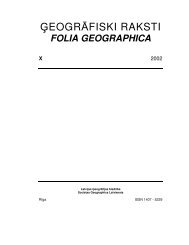eogrÄfiski raksti folia geographica xii - Ä¢eogrÄfijas un Zemes zinÄtņu ...
eogrÄfiski raksti folia geographica xii - Ä¢eogrÄfijas un Zemes zinÄtņu ...
eogrÄfiski raksti folia geographica xii - Ä¢eogrÄfijas un Zemes zinÄtņu ...
Create successful ePaper yourself
Turn your PDF publications into a flip-book with our unique Google optimized e-Paper software.
81<br />
DEVELOPMENT OF PLACES AND REGIONS<br />
The criteria for scoring<br />
(1) Responsible marketing department and its effectiveness:<br />
3 – The city has a separate administrative department (or several departments that coordinate<br />
their operations) to take care of the city’s marketing in an effective way;<br />
2 – There are one or more administrative departments to take care of the city’s marketing,<br />
but the operations are not sufficiently effective;<br />
1 – There are several administrative departments to consider city marketing, but their<br />
mutual work is poorly co-ordinated;<br />
0 – There are no departments in the city to handle city marketing issues.<br />
(2) The marketing strategy and documents that regulate it:<br />
3 – There is a long-term marketing strategy;<br />
2 – A long-term marketing strategy is being elaborated;<br />
1 – Marketing processes are organised without short-term plans of action;<br />
0 – There is no marketing strategy, events are planned at random.<br />
(3) The logo:<br />
3 – The logo typifies the city, it is successful, the target audience recognises it;<br />
2 – The logo typifies the city, but it has only just been introduced or is temporary;<br />
1 – The logo is little known and has not been advertised much, or a competition has been<br />
anno<strong>un</strong>ced to find a designer for a logo;<br />
0 – The city has no logo.<br />
(4) The slogan:<br />
3 – The slogan typifies the city, it is successful, and the target audience recognises it;<br />
2 – There are several descriptive slogans, one for each target audience, or more than one<br />
slogan for a single target audience;<br />
1 – There is a slogan that few people know about, or a competition has been organised to<br />
find a slogan;<br />
0 – There is no permanent slogan.<br />
(5) The city’s image and the extent to which it is concrete:<br />
3 – The city has a positive, concrete and perceivable image;<br />
2 – The city has a positive image, but it is not concrete;<br />
1 – An image for the city is being sought, but the descriptive identities have not really<br />
been defined;<br />
0 – The city has a negative image or one that must be changed (repositioned).<br />
(6) The infrastructure and the presentation of the city as a “<strong>un</strong>ified” product:<br />
3 – The infrastructure is in good shape, there is a <strong>un</strong>ified design for signs that point to<br />
tourist attractions;<br />
2 – The infrastructure receives investments each year, a <strong>un</strong>ified design for signs that point<br />
to tourist attractions exists or is being designed;<br />
1 – Insignificant money is invested in infrastructure, the design for signs that point to<br />
tourist attractions is weak, or there is no <strong>un</strong>ified design;<br />
0 – The infrastructure is in poor shape, there is no <strong>un</strong>ified design for signs that point to<br />
tourist attractions.<br />
(7) Tourism resources and tourist attractions:<br />
3 – There are many tourism resources, new tourist attractions have been or are being<br />
created;<br />
2 – There are a limited number of tourism resources, but new tourist attractions are being<br />
created;<br />
1 – There are a few tourism resources, but their number is insufficient;<br />
0 – There are no meaningful tourism resources and tourist attractions.

















